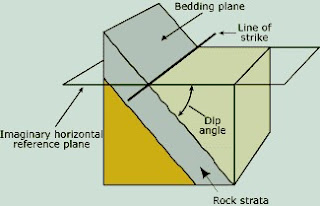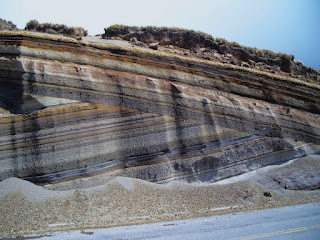Sedimentary rocks
Sedimentary Rocks
Sedimentary Rocks Sedimentary rocks include all rocks formed by deposition in beds or layers (strata) of the material derived from older rocks and also cover rocks formed by chemical or organic agencies. The materials may be carried by water, wind or glacier, e.g., in the case of sandstone, shale, etc. The majority of these sedimentary rocks are formed by deposition on riverbeds, or seabed and into basins or depressions on the earth's surface. The consolidation of loose sediments into hard also by deposition of cementing materials into spaces between particles of the sediments. The chief cementing materials or some mineral finely spread throughout the rock. The colour of the rock often changes on account of alteration of the original constituents due to atmospheric agencies, chiefly water. The sedimentary rocks were formed practically in the horizontal position but due to earth movements associated with earthquakes or other causes, they were tilted from the horizontal position.Alluvium is a loose or unconsolidated deposit resulting from the breaking up of the bedrock. The broken particles either remain in position or are moved by surface water and are redeposited elsewhere as a more or less loose deposit which may convert into unconsolidated ' rock. The Indo-Gangetic plain has a thick layer of alluvium, several thousand metres thick
Some sedimentary rocks are formed from plant or animal remains e.g., coal and some form of limestone. There are some sedimentary rocks which are formed by deposition of material which was once in solution in water but later on separated from it, e.g., some deposits of limestone, ironstone (hematite), gypsum, etc. Where the water carrying carbonates in solution escape drop by drop from the rock in cavities or fissures, the carbonates may deposit in the form of rods or columns of rock. If the deposit is on the floor it is known as stalagmite and if it is hanging from the roof it is known as stalactite.
Placers are friable sandy-clay, sandy-gravel or similar
formations containing some rare metal or mineral such as gold,
platinum, tinstone, etc.
The rocks adjoining a seam but below it is called the floor of the
seam and those above it are called the roof of the seam. In the metal mining
practice, the rocks adjoining an orebody are called its wall rocks, the
handing wall being above the ore body and the foot wall being
below it.
Bedding Plane: In a sedimentary rock, a bedding plane is the junction plane of one bed of rock with another. Bedding planes are therefore the surfaces which divide the different layers of water deposited or wind-deposited sediments and are planes of weakness in the rock as the coherence between different beds is usually less than within a bed. Splitting is therefore usually easy along a bedding plane. Bedding planes are a feature common to all sedimentary rocks and to some metamorphic rocks which were derived from them.
Bedding Plane: In a sedimentary rock, a bedding plane is the junction plane of one bed of rock with another. Bedding planes are therefore the surfaces which divide the different layers of water deposited or wind-deposited sediments and are planes of weakness in the rock as the coherence between different beds is usually less than within a bed. Splitting is therefore usually easy along a bedding plane. Bedding planes are a feature common to all sedimentary rocks and to some metamorphic rocks which were derived from them.
 |
| Bedding planes |
Dip and Strike: The strike of a bed is a level line on its surface. In effect, it is a contour line in the plane of the bed. The line of true dip J w-; in a bed or surface is the steepest line in the inclined surface and is not rounded but angular, the rock is called breccia always at right angles to the strike (Fig.). The dip of a bed along any direction between the strike and the true dip is called its apparent dip.
 |
| dip and strike |
Unconformity: When rocks are deposited other one above the in uninterrupted succession, they are said to be When conformable. they are laid down upon the eroded surface of older strata, the two series of strata are said to be unconfirmable and the plane of contact between them is called an unconformity. An unconformity is evident chiefly by the difference of dips between underlying and overlying series of rocks and also by denuded and eroded surfaces of older series of rocks and also by denuded and eroded surfaces of older series and the presence of conglomerate at the base of upper series. (Fig).
 |
| Unconformity |
The common sedimentary rocks are:
Conglomerate: It consists of rounded pebbles embedded in a finer-grained material forming the rock. Conglomerates occur in lens-shaped masses and not in the form of regular bds. If the pebbles are not rounded but angular then the rock is breccia.Fig. 1.4
Sandstone: This consists of particles of quartz cemented together, usually by silica, and sometimes by calcite or other cementing materials. The colour of the sandstone depends upon the cementing materials. Sandstones are porous in nature and permit water or other fluids like gases to flow through the pores. The rocks are of common occurrence in the coalfields.
Shale: This consists chiefly of clay and has a fine texture. It can be split along the bedding planes and also into thin leaves of one millimetre or so.
Fireclay: It is a van ety of clay described earlier. It is a refractory material, i.e. one capable of resisting very high temperatures without becoming soft or plastic.
Laterite: Laterite is a red ferruginous porous clay, formed by weathering of such rocks as basalt, mica schist and gneisses and composed chiefly of alumina and iron oxide. It is found up to a depth of nearly 3m in the eastern part of Raniganj and Talchir coalfields. Laterite is the common surface. rock in iron ore localities.
Limestone: It consists of CaC03 (Carbonate of lime) with small impurities. Some limestones are made up of shells of organic origin, others are formed due to the deposition of calcite from solutions. Chalk is a soft porous variety of limestone.
One of the occurrences of limestone is in the form of sea sand and near Dwarka (Gujarat) such sea sand is derdged out from the seabed and used for the manufacture of cement. it is soft compared to the sand formed out of Quartz.
Fireclay: It is a van ety of clay described earlier. It is a refractory material, i.e. one capable of resisting very high temperatures without becoming soft or plastic.
Laterite: Laterite is a red ferruginous porous clay, formed by weathering of such rocks as basalt, mica schist and gneisses and composed chiefly of alumina and iron oxide. It is found up to a depth of nearly 3m in the eastern part of Raniganj and Talchir coalfields. Laterite is the common surface. rock in iron ore localities.
Limestone: It consists of CaC03 (Carbonate of lime) with small impurities. Some limestones are made up of shells of organic origin, others are formed due to the deposition of calcite from solutions. Chalk is a soft porous variety of limestone.
One of the occurrences of limestone is in the form of sea sand and near Dwarka (Gujarat) such sea sand is derdged out from the seabed and used for the manufacture of cement. it is soft compared to the sand formed out of Quartz.
Dolomite: It is a compound of CaCO3 and MgC03 in various propotions.
Fossils
Fossils are the remains or traces of former living creatures or plants now preserved in rocks. Although the earth is estimated to be at least 4000 million years old, man’s footprints and bones do not appear in the fossil record until about one million years ago. The remains of plants or creatures are mostly in decayed or decomposed Bones, teeth or shells of animals state sometimes even the footprints, the wood or leaves of trees, and fossils. Such fossils or tracks of animals are preserved as generally found in fine-grained rocks such as sedimentary limestone, shale, etc. They are not found in igneous though bedded rocks, volcanic tuffs (fragmentary materials ejected by volcanoes) may occasionally contain some fossils. To the geologist, fossils are useful as their study gives a clue to:- The climate of the period during which the enclosing rock was laid down.
- The nature of the rock, whether it is a deposit in fresh water, sea or on land.
- The relative age of the rocks belonging to a particular period extending over thousands of years is characterised by the same fossils over a wide area.
- The geography of past ages, i.e. the situation of ancient continents, seas, etc.
- The evolution of life throughout geological time.









Comments
Post a Comment